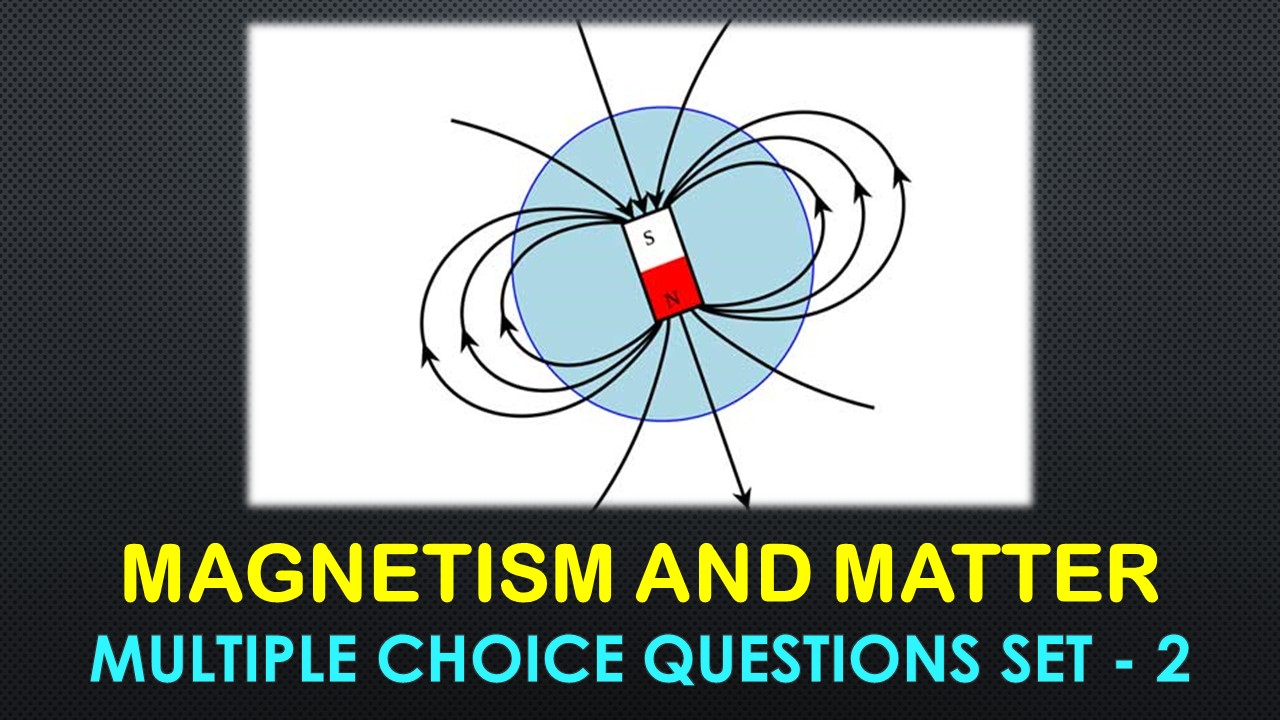CBSE Class 12 Magnetism and Matter Multiple Choice Questions with Answers. MCQ Questions Class 12 Magnetism and Matter with Answers Is Prepared Based on Latest Exam Pattern. Students can solve NCERT Class 12 Magnetism and Matter MCQs with Answers to know their preparation level.
Students who are searching for NCERT MCQ Questions for Class 12 Magnetism and Matter with Answers are compiled here to get good practice on all fundamentals. Know your preparation level on MCQ Questions for Class 12 Magnetism and Matter with Answers. You can also verify your answers from our provided MCQ Class 12 Magnetism and Matter with Answers. So, ace up your preparation with MCQ of Class 12 Physics Examinations.
MCQ Questions Class 12 Magnetism and Matter with Answers - Set - 2
Question 1:
Which of the following has a low value in ferrites?
(a) Conductivity
(b) Permeability
(c) Magnetic susceptibility
(d) All the above
Correct Answer – (A)
Question 2 :
S.I. unit of flux is :
(a) Ohm
(b) Weber
(c) Tesla
(d) None
Correct Answer – (B)
Question 3 :
At Curie point of ferromagnetic material becomes
(a) Diamagnetic
(b) Paramagnetic
(c) Strongly ferromagnetic
(d) non-magnetic
Correct Answer – (B)
Question 4 :
A magnetic needle suspended by a silk thread is vibrating in the earth’s magnetic field. If the temperature of the needle is increased of 700°C, then
(a) time period increases.
(b) time period decreases.
(c) time period remains unchanged.
(d) the needle stops vibrating.
Correct Answer – (D)
Question 5 :
Susceptibility of a magnetic substance is found to depend on temperature and the strength of the magnetising field. The material is a:
(a) Diamagnet
(b) Paramagnet
(c) Ferromagnet
(d) Superconductor.
Correct Answer – (C)
MCQ Questions Class 12 Magnetism and Matter with Answers
Question 6 :
What is the angle of dip at a place where the horizontal component of earth’s magnetic field is equal to the vertical component?
(a) 0°
(b) 30°
(c) 45°
(d) 90°
Correct Answer – (C)
Question 7 :
The absence of magnetic monopole is explained by
(a) Gauss’s law
(b) Coulomb’s law
(c) Lorentz’s Law
(d) Fleming law.
Correct Answer – (A)
Question 8 :
Isogonic lines on magnetic map represent lines of:
(a) Zero declination.
(b) equal declination.
(c) equal dip.
(d) equal horizontal field.
Correct Answer – (B)
Question 9 :
A uniform magnetic field is obtained in a:
(a) bar magnet
(b) horse shoe magnet
(c) circular coil carrying current
(d) None of these.
Correct Answer – (A)
Question 10 :
Domain formation is the necessary feature of
(a) Diamagnetism
(b) Paramagnetism
(c) Ferromagnetism
(d) All of these.
Correct Answer – (C)
- NCERT Solutions Class 11 Chemistry Chapter 1 : Some Basic Concepts of Chemistry
- NCERT Solutions Class 11 Chemistry Chapter 2 : Structure Of The Atom
- NCERT Solutions Class 11 Chemistry Chapter 3 : Classification of Elements and Periodicity in Properties
- NCERT Solutions Class 11 Chemistry Chapter 4 : Chemical Bonding and Molecular Structure
- NCERT Solutions Class 11 Chemistry Chapter 5 : States of Matter
- NCERT Solutions Class 11 Chemistry Chapter 6 : Thermodynamics
- NCERT Solutions Class 11 Chemistry Chapter 7 : Equilibrium
- NCERT Solutions Class 11 Chemistry Chapter 8 : Redox Reactions
- NCERT Solutions Class 11 Chemistry Chapter 9 : Hydrogen
- NCERT Solutions Class 11 Chemistry Chapter 10 : The s-Block Elements
- NCERT Solutions Class 11 Chemistry Chapter 11 : The p-Block Elements
- NCERT Solutions Class 11 Chemistry Chapter 12 : Organic Chemistry: Some Basic Principles and Techniques
- NCERT Solutions Class 11 Chemistry Chapter 13 : Hydrocarbons
- NCERT Solutions Class 11 Chemistry Chapter 14 : Environmental Chemistry




